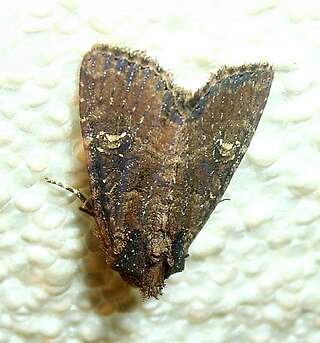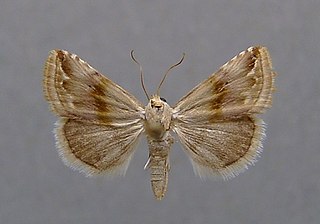
Apamea crenata, known as the clouded-bordered brindle, is a moth in the family Noctuidae. It is distributed throughout the Palearctic realm. In the North it crosses the Arctic Circle, in the Mediterranean it is found only in cool locations and mountains avoiding very hot areas. In the Alps, it rises to an altitude of about 2000 metres.

Lygephila pastinum, the blackneck, is a moth of the family Erebidae. The species was first described by Georg Friedrich Treitschke in 1826. It is found in Europe and across the Palearctic Siberia, the Russian Far East, Japan and China.

Paratalanta pandalis is a species of moth of the family Crambidae. It is found in the Palearctic including Europe.

Helotropha leucostigma, the crescent, formerly Celaena leucostigma is a moth of the family Noctuidae. It is found in the Palearctic realm.

Xanthia gilvago, the dusky-lemon sallow, is a moth of the family Noctuidae. The species was first described by Michael Denis and Ignaz Schiffermüller in 1775. It is found in Europe.

Synthymia is a genus of moths of the family Noctuidae. It contains only one species, Synthymia fixa, The Goldwing, which is found in southern Europe and North Africa.

Catocala nymphagoga, the oak yellow underwing, is a moth of the family Erebidae. It is found in Southern Europe, from Bulgaria up to the Iberian Peninsula and sometimes further north as a migrant. It is also found in North Africa and Asia Minor.

Mesapamea secalis, the common rustic, is a moth of the family Noctuidae. The species was first described by Carl Linnaeus in his 1758 10th edition of Systema Naturae. It is found in Europe, north-west Africa, Turkey and northern Iran.

Apamea unanimis, the small clouded brindle, is a moth of the family Noctuidae. The species was first described by Jacob Hübner in 1813. It is native to Europe, Turkey, Azerbaijan, and western Siberia. It has been introduced in North America and can now be found in Ontario, Quebec, New Brunswick, New York, Michigan, and Wisconsin.

Lygephila craccae, the scarce blackneck, is a moth of the family Erebidae. It is found in temperate Europe and across the Palearctic to the Altai Mountains, Korea, Japan and China.

Agrochola litura, the brown-spot pinion, is a moth of the family Noctuidae. The species was first described by Carl Linnaeus in 1761. It is found in Europe and the Middle East. It is possibly also present in North Africa, but this is unclear because similar looking species Agrochola meridionalis is found there.

Eublemma ostrina, the purple marbled, is a moth of the family Erebidae. The species was first described by Jacob Hübner in 1808. It is mainly found in central and southern Europe, and further east, but is also a scarce migrant in the United Kingdom, where it is mainly found along the south coast.

Chloantha hyperici, the pale-shouldered cloud, is a moth of the family Noctuidae. It is found in southern Central Europe and from southern Europe to the Near East and Anatolia, Israel, Iraq, the Persian Gulf and the Caucasus, as well as northern Denmark, southern Sweden, southern Norway and south-western Finland.
Acleris supernova is a species of moth belonging to the family Tortricidae. It is found in Ecuador.

Elaphria venustula is a moth of the family Noctuidae. It is found in most of Europe, except the north. In the east, the range extends through the Palearctic to the Pacific Ocean.
Sameodes furvipicta is a moth in the family Crambidae. It is found in Papua New Guinea.
Syllepte sulphureotincta is a moth in the family Crambidae. It was described by George Hampson in 1918. It is endemic to Mozambique.
Udea binoculalis is a moth in the family Crambidae. It was described by George Hampson in 1904. It is found on the Bahamas.
Stenoma sublimbata is a moth of the family Depressariidae. It is found in Panama, Colombia, Peru and Bolivia.

Asaphodes prymnaea is a moth in the family Geometridae. It is endemic to New Zealand and can be found on the Mount Arthur tableland. It is common in limestone valleys. The female of the species is paler and has less distinctive markings than the male. Adults are on the wing in January and February.














